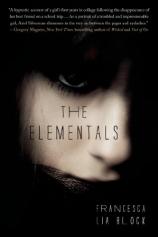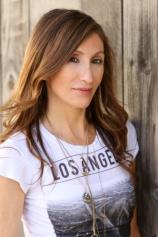The Elementals
Review
The Elementals
Fantasy comes in many flavors, and I like them all: the kind that takes place in a wholly invented land (The Lord of the Rings; The Hunger Games), the kind that catapults a person from our world into a fictional land (the Narnia and Oz books), and finally the kind --- of which THE ELEMENTALS is an example, along with the Twilight series, ROSEMARY’S BABY and many others --- where a contemporary protagonist finds supernatural elements invading her everyday life. The juxtaposition of the occult and the realistic makes for some eerie stories.
Ariel (“like in THE TEMPEST”) Silverman, on the verge of turning 18, is vulnerable from the start. Her best friend, Jeni, vanished on a pre-college visit to Berkeley --- the case is still unsolved --- and her mother has been diagnosed with breast cancer. Although some of her angst is the sort all new collegians grapple with, she brings more pain and imagination to the dorm room than, for example, her cashmere-sweater- and diamond-stud-wearing roommate, Lauren. References to Arthur Rackham posters and Celtic myths suggest that Ariel already has one foot in fairyland.
But fairyland is a less benign place than you might imagine. Early in Ariel’s first year at UC Berkeley, she is given a flyer for a Halloween party at an old house in the hills. The hosts are Tania, Perry and John, a trio of beautiful young eccentrics who seem eager to adopt her. Their seduction techniques are distinctly California-esque: tarot cards, vegetarian feasts, floating neo-hippie garments, mysterious (drug-laced?) drinks, erotic challenges. Is it any wonder that she falls for the ravishingly attractive (sleek black hair, green eyes, high cheekbones) John Graves?
"THE ELEMENTALS is beautifully if sometimes self-consciously written, with a far richer vocabulary than most teen fantasies.... For teenagers --- and perhaps their fantasy-loving mothers --- this book could be the read of their dreams."
In a rush of lust and self-discovery, she moves into the hillside house, neglecting her search for clues to Jeni’s disappearance. Guilt assails her; maybe she is betraying her friend by taking a lover? There is a homoerotic flavor to her memories of Jeni (at 15, they practiced kissing on each other), and it’s clear that Ariel’s metamorphosis from naive adolescent to grown woman also involves moving from same-sex twinning to the raptures of heterosexual love.
Ariel’s relationship with her mother also evolves. In her sophomore year, she goes home for a while after a falling-out with her spooky roommates. At first she feels like “a girl in a tower or one who slept in a briar-covered castle or a glass box” --- in a trance, spellbound. But when she learns that her mother must have more surgery, followed by a course of chemotherapy, she comes down to earth and becomes extraordinarily supportive. Her mother loses her hair; in solidarity, Ariel shaves her own head.
Then, drawn by memories of love and friendship, she returns to Berkeley for her junior year. This time she boards with Pierrette, a fabric and jewelry maker, and her three-year-old son, Michelangelo --- an organic little family that accepts rather than seduces her. Ariel starts to make collages that, like the novel itself, fuse mementos of her real life with fantastical imagery: tulle, glitter, flower petals, pictures of fairies and angels, personal photographs, pieces of fabric, bits of stories and poems. The work helps her to become whole. I won’t give away the denouement, but you feel that by the time Ariel graduates, she will be a far cry from the frail, scared girl you met in chapter one.
In short, this is a coming-of-age story threaded with supernatural motifs, and it is billed as Block’s “breakthrough adult novel” (she has written 28 books, many of them for teens). Now, I don’t care about which age category fantasy is put in, as long as it’s good. But apart from the sex scenes, which (fair warning to parents) are quite explicit, to me THE ELEMENTALS still feels like a YA title.
Although Block’s adolescent protagonist has considerable depth, she is half a child, with a child’s narcissism and self-indulgence. Thus, at times the book gets a bit bogged down in amateur detective work, obsessive visions, and increasingly weird sexual encounters, one in a graveyard and another particularly lurid scene (“Every orifice was waiting to receive him” --- oh, dear) during which Ariel imagines Jeni watching her and John make love. It’s almost as if Block is out to prove that she is just as equipped to write erotica as, say, E.L. James.
And yet, when the author isn’t dabbling in Christian Grey territory, THE ELEMENTALS is beautifully if sometimes self-consciously written, with a far richer vocabulary than most teen fantasies. Ariel adores words (her favorites include “Effulgent. Radiant. Illumine. Scintillate. Pellucid. Luminous.”), and obviously Block does too, showing off a lush style that conjures and sustains an appropriately mysterious atmosphere. This is particularly evident in the stories John tells Ariel, evoking an older earth in which “Eve’s children” lived close to nature, with humans turning into trees or animals, or a fantastic amalgam of both (“A man stroking the crevice of a eucalyptus tree until it changed into a dryad. … A strange woman who took a sleeping man and made him her horse. … A beautiful girl dressed in bells and crystals with the hooves of a goat instead of feet”).
The key to the book’s very title is this radically different relationship to the natural world, by turns sacred, sensual and threatening (Block’s novel, come to think of it, isn’t so far removed from Twilight or True Blood territory --- without the vamps or werewolves). On the second Halloween Ariel spends with her mentors, they dress up as “elementals,” or nature spirits: “A bit like a fairy but that word’s been done to death, don’t you think?” Tania says. “The elements. I’m fire. Perry’s earth. Johnny’s water. That’s why we needed you, Sylph. … You’re air.”
Flattered to be wanted, but fearful that joining the Elementals’ tribe will mean losing herself, Ariel remains ambivalent almost to the end. The complexity of her response taps into the fascination that girls, especially girls on the cusp of womanhood, have for enchantments of all kinds. Some of it relates back to a childhood passion for stories about magical realms, the happy-ever-after sort and the darker, grimmer variety. And some of it is a projection into a yearned-for romantic/erotic future. Ariel represents both, and so does THE ELEMENTALS. For teenagers --- and perhaps their fantasy-loving mothers --- this book could be the read of their dreams.
Reviewed by Kathy Weissman on November 9, 2012
The Elementals
- Publication Date: September 17, 2013
- Genres: Fiction
- Paperback: 272 pages
- Publisher: St. Martin's Griffin
- ISBN-10: 1250036291
- ISBN-13: 9781250036292





